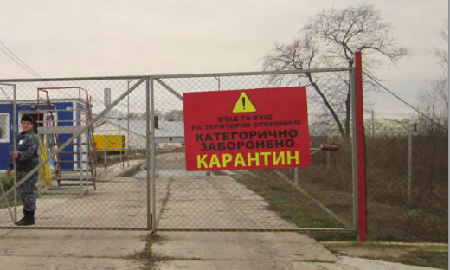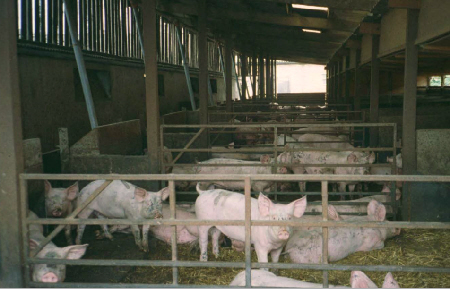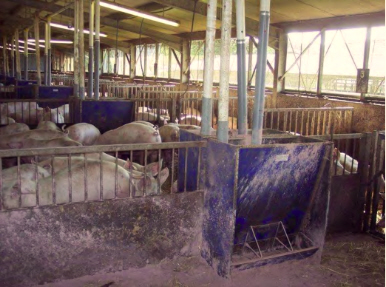



Preparing for the Changing Landscape in EU Pork Safety
The British Pig Executive (BPEX) recently held a series of meetings highlighting the growing importance of Salmonella control on pig units, with speakers offering practical advice on minimising the risks of a farm becoming Salmonella-positive. Stuart Lumb reports for ThePigSite.Over Christmastime in England, many unfortunate folk woke up to find that the local landscape had changed due to the terrible floods. Changes are occurring in the pig industry, as UK pig producers are finding out. Food safety scares are hitting the headlines far too often – witness the 'Horse-gate' scenario – and the fickle consumer has to be confident that the pork he or she eats is safe.
'Produce Safe Pork' was the message being put across in no uncertain terms to pig producers at a number of BPEX meetings held recently throughout the country. Opening the York meeting, BPEX food-service trade manager, Tony Goodger, reminded producers of recent food scares and that a significant number of consumers - 53 per cent in a 2011 YouGov Food safety survey - believe that farmers should be responsible for food safety.
Salmonella scares are food and drink - excuse the pun - to the media and this is an issue that will not go away.
Closer Salmonella Monitoring

Becky Gosling of the Animal Health & Veterinary Laboratories Agency (AHVLA) based at Weybridge in Surrey explained that new EU legislation will require abattoirs to identify farms where pigs show regular Salmonella contamination.
The Food Standards Agency (FSA) will now closely monitor all abattoir testing results and abattoirs will have to agree an action plan with the FSA if target levels are exceeded. Farms will be checked for their biosecurity standards. Those farms that are identified as high risk will be referred to Defra and will be required to reduce their Salmonella levels.
Biosecurity Minimises Disease Risk
Senior consultant with ADAS, David Moorehouse, highlighted the importance of biosecurity, defining it as the measures taken to minimise the risk of introduction of new and emerging diseases and spread of infectious agents within the unit, in order to keep pigs healthy.
Risk cannot be eliminated but it can be managed, he said.

Good biosecurity reduces the cost impact of disease by:
- reducing mortality
- improving efficiency of production
- reducing vet and medicine costs
- maximises genetic potential of the pigs and
- improves staff morale, which has a knock-on effect on unit productivity. A poorly performing unit caused by disease impacts negatively on staff enthusiasm.
External biosecurity involves keeping diseases out of the unit. One of these measures should mean effective isolation and quarantine of incoming gilts and boars.
Many pig units are badly laid out and have just expanded over the years, however, with a green-field site, many good biosecurity features can be built into the design and lay-out, such as a substantial perimeter fence, limited access points, along with vehicle disinfectant sprays and wheel baths.
Mr Moorehouse works a great deal in the Ukraine and cited the extreme lengths that some units go to regarding biosecurity, which may involve the provision of armed guards and CCTV. Only vehicles on an approved list can enter the unit there, and their number plates are checked before access is allowed on to the farm.
He added that it is vital that the health status of the unit is known: it should be discussed with the unit vet and form part of the Veterinary Health Plan (VHP).
The significance of each disease should be recognised and then plans developed to
- control the disease if you are positive
- keep it out if you are negative, and then
- eradicate it – but that is easier said than done
Most farms had a written biosecurity plan but in practical terms, parts of it may not be being adhered to.

Practical Biosecurity Measures on the Farm

Bedford-based vet, David Chennells, appears on many platforms and has the canny knack of being able to put across serious scientific messages in an entertaining and thought-provoking manner.
At this meeting, he emphasised that biosecurity measures are put in place to control both groups of diseases and individual ones, involving the use of vaccines, All-In / All –Out, no mixing, single age groups, stress reduction, good ventilation, prevention of faecal build-up etc.
Mr Chennells flagged up Salmonella as the ideal 'demonstration organism' as it is common and widespread plus very difficult to eradicate “but if you can control Salmonella you can control most other diseases,” he said.
He continued: “The three most likely places to find Salmonella are in the foot-well of tractors that scrape out solid-floored dung passages, on the unit staff room floor and in mouse faeces found in clean buildings.
“Rats and especially mice are a haven for Salmonella organisms and are found in huge numbers as these two pests can multiply so quickly themselves.”
Plus how many pig units have cats and dogs wandering freely about everywhere? They certainly do not use foot dips, he said.
Regarding disinfection, surfaces must be free of faecal material - as you cannot disinfect faeces - mud and grime for disinfection to work and buildings must be given time to dry out. The two best disinfectants are ultra-violet light and warm dry air.
Iowa State University research indicates that “whole building cleaning/disinfection results in better performance. For boot dips, two are essential – one for washing alongside a second one for disinfection.
The Chennells 'sandwich–clean' concept is as follows: “You put your sandwiches on the slats – then, would you eat them?”
The most bio-secure types of buildings and systems have the following characteristics:
- All-In, All-Out
- Slatted floors
- No shared scraped –through dung passages
- Single air spaces
- Single age cohorts
- Batch farrowing : increases the age gap between groups
- No nose-to-nose contact between pens
Hence the Suffolk-type finishing house, which is high and airy, allowing birds and vermin easy access, has solid-floored scrape-through dung passages and tubular gates which allow nose-to nose contact typifies all that a good biosecure building should NOT be.

Mr Chennells continued that there are a number of options for All–In / All-Out systems:
- by unit – single site
- by building – mixed age site
- by room – mixed age, building and site, and
- by population - age cohorts
Reinforced with effective cleaning and disinfection practices, there are a number of other benefits of All–In / All-Out batch farrowing, he continued:
- batching removes any animals which may be carrying disease
- removes all manure, dust bedding and feed, which can harbour disease
- cleans and rests the whole building: slats, troughs, fans etc.
Rodent Control
Rodents spread and carry a whole host of diseases, plus cause significant damage to pig buildings and so a paper on effective rodent control was devoted solely to this very important topic, presented by Paul Butt of Natural England (part of Defra).
Rodents pose a significant disease threat, he said, with rats and particularly mice acting as a reservoir for Salmonella and other economically damaging infections. Infections threaten biosecurity and compromise disinfection procedures. In addition, unit staff are at risk from diseases transmittable to Man.
In a cold winter, nice warm piggeries full of feed are very attractive to “our furry friends”, not to mention feed that has that has spilled out on the ground from badly adjusted feed lines or from broken bags.
Often ad-lib feed hoppers are bolted to pen divisions to stop pigs moving them. However, feed can build up behind the hoppers and, even with rigorous power washing, not all this feed is removed, leaving it for rodents to consume later.
It is difficult to make insulation materials rodent-proof plus the cavities created make ideal nesting sites.
Mr Butt went on to highlight a number of rodent control options:
- contractors – these can be national or regional companies or local pest controllers
- train unit staff to act as pest controllers, or
- use a combination of a contractor with unit staff pest controllers.

Salmonella Control through the Feed
Rob Davies who is also based at the AHVLA closed the meeting with some excellent take-home tips.
To check whether Salmonella is coming in with your replacement gilts and boars, test your incoming breeding pigs and tell your supplier that you are checking them for Salmonella.
Your feed programme may be “feeding” Salmonella.
Rations that contain a large amount of wheat, are finely ground and are pelleted ferment rapidly in the gut, allowing Salmonella (and E. coli) to pass too quickly through the stomach acid barrier, and grow in the gut.
Incidentally, Mr Davies explained that fine grinding also favours stomach ulcers and gut problems such as scour, bloat and dysentery. Wheat can be replaced with barley and ingredients can be ground more coarsely.
Wet feed units should introduce a fermentation step and use dairy co-products if it is a cost-effective option, he said.
“Most farmers do a reasonable job of disinfecting farrowing and weaner houses but this usually delays infection until the pigs are closer to finishing. This increases the public health risk as later infections don’t often subside by slaughter age.
“Make sure that you include finishing houses in the routine cleaning and disinfection programme as this should have health benefits for the pigs too. To do any good, use disinfectants that work well against residual muck, e.g. glutaraldehyde-based ones, and don’t forget to sanitise regularly inside the water lines too,” he continued.
Mr Davies said: “Salmonella vaccines can help reduce Salmonella Typhimurium and similar strains. Vaccination of sows by injection can provide improved protection for weaned piglets, and it’s also possible to vaccinate growing pigs orally.”
On outdoor units, Mr Davies said: “It’s a myth that wild animals are a big risk for outdoor pigs. The types of Salmonella that the pigs have are those that came in with the pigs. After that, the soil in the paddocks becomes heavily contaminated and that’s the main source of subsequent infections.”
January 2014








